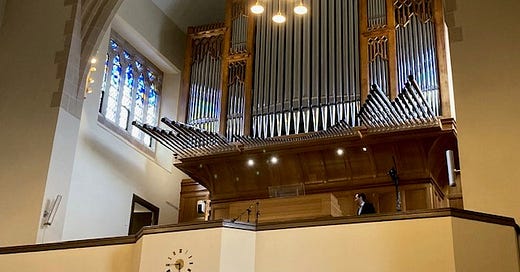Reflections on London Organ Day 2024
As you walk west along Kensington High Street you will come to the stone portico little wider than a car that forms the entrance to the church of Our Lady of Victories. Walking into the church reveals a Tardis-like interior, with a high roof and a beautiful golden altar backcloth. Turn around and you will see the new Skrabl IV/55 organ installed in the West Gallery in 2022.
(You can find a list of Skrabl organs in the UK on the firms’ web site.)
This was the venue of the IAO London Organ Day 2024 on the theme of Gregorian Beauty. The objective was to explore the way in which composers have been inspired by Gregorian chants. There were around 80 in the audience but far too few younger organists. The day started with a demonstration by Timothy Maklin (the organist of the church) of the capabilities of the Skrabl organ. Given the historic relationship between the Romanian and French languages it should come as no surprise to see an organ with the classic Cavaille-Coll terraced stop jambs. In reality it is a three-manual organ with a fourth Bombarde manual with just 8’ and 4’ flutes and en chamade trumpets at 16’, 8’ and 4’. The NPOR specification indicates that the three pedal 32’ ranks are electronic but that is not noted in the programme specification or on the church’s web site. The reverberation period of the church is around 3-4 seconds.
The opening recital was given by Ben Bloor. He briefly introduced his programme and then played music by Leonce de Saint-Martin, Matthew Martin, Guilmant, Fauchard (with a lot of thumbing down from Recit to Positive), Joulan, Langlais and finally Antiphonies, the only major composition by William Mathias based on pre-composed secular and liturgical themes. Given the theme of the day and the organ it would have been interesting to hear some Tournemire and perhaps Litanies by Jean Alain. Ben’s virtuosity is simply stunning, but for some reason there were extensive biographies of the participants in the brochure for the day but no programme notes. After his introduction Ben played all seven pieces in a single sequence. It would perhaps have been helpful to have heard the chant that formed the basis of the composition played over before each piece.
After refreshments Sebastian Thomson played four of the pieces he has commissioned on the theme of The Angels of Creation. A couple of pages of the score of the contribution of Thomas Hewitt Jones will give you a good sense of the approach taken by Simon Walley, David Bednall and John Hosking in their contributions. It opens with Cochereau-like RH tremolo chords and LH cluster chords in F# major!
In introducing his recital Sebastian did mention that he was not entirely convinced that the four pieces worked together as a recital. He was right. It was rather like listening to the final movements of Vierne’s last four organ symphonies played without a break. Sebastian’s playing, as with Ben Bloor, was superb and we have to congratulate Sebastian for his vision in commissioning these pieces. But as with Ben’s recital, I would have welcomed at least a short spoken introduction before each piece, and again some programme notes. Interestingly the Bombarde trumpets could not be heard above the Grand Orgue. I suspect that the perspective of the performer (seated underneath them) and the audience is acoustically different.
The first session in the afternoon was an excellent introduction to Gregorian chant by Martin Baker, with many sung illustrations from a lay clerk at Westminster Cathedral who was a last-minute stand-in. I regret I did not catch his name but his tenor voice was magical. Martin walked us through the basics of Gregorian chant and for the first time I understood the difference between Authentic and Plagal nodes. Martin clearly started to run out of time, which was a pity because he had just reached a consideration of how to accompany Gregorian chant, something that I never do convincingly. It was fascinating to learn that the approach taken at Westminster Cathedral is different to that used by Ben Bloor at the London Oratory. So there is no ‘correct’ way!
A family commitment meant that I could not stay for the concluding recital by Ourania Gassiou, a pupil of Nicolas Kynaston. Her programme included John Bull, J.S.Bach, Martin Baker and an ad alternim Salve Regina from Olivier Latry, a performance of which you can watch at this link from St Sulpice.
It was certainly a day for virtuoso performances of music that I suspect most of the audience would never be able to play, and much less perform in a parish church. Nevertheless, this was quite inspiring – a glimpse of what is possible with hours of practice. However, the lack of programme notes and a rather unbalanced recital programme meant that I left somewhat disappointed despite having gained much from the day.




